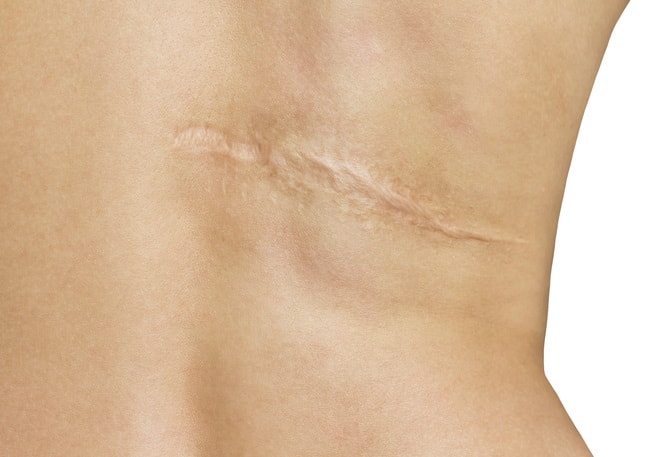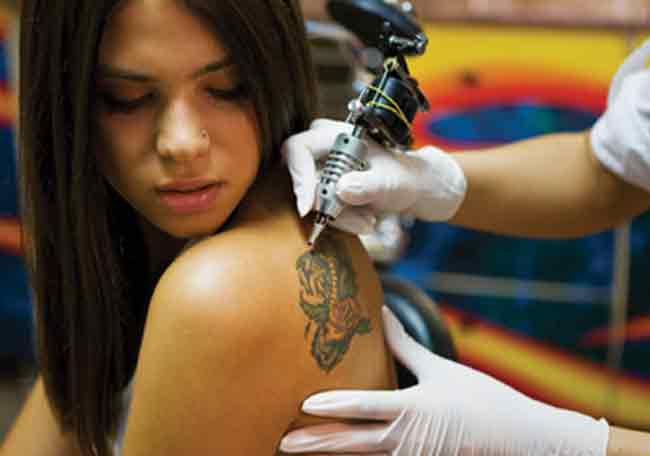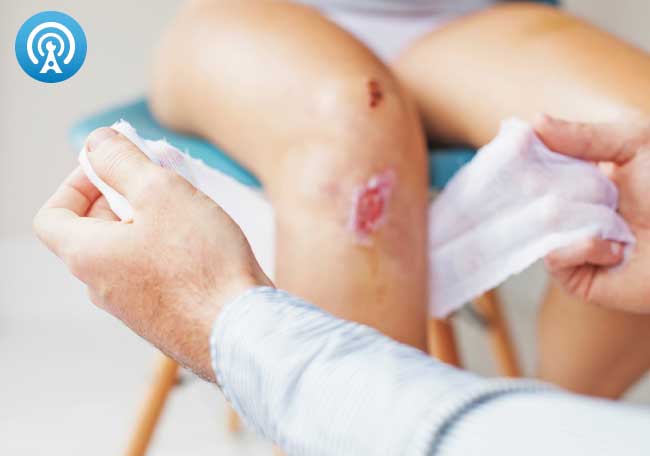Oxandrolona y propranolol | 06 ENE 20
Quemaduras: reducción de la cicatrización hipertrófica
Los autores hipotetizaron que la administración de oxandrolona y propanolol por un año, a niños severamente quemados, podría atenuar el desarrollo de cicatrices hipertróficas, midiendo objetivamente las características in vivo de la cicatriz y la función física global reportada por el paciente

Autor/a: Herndon D, Capek KD, Ross E, Jay JW, Prasai A y colaboradores Ann Surg 2018; 268(3): 431-441
Página 1
- Porter C, Tompkins RG, Finnerty CC, et al. The metabolic stress response to burn trauma: current understanding and therapies. Lancet. 2016;388:1417–1426.
- Jeschke MG, Gauglitz GG, Kulp GA, et al. Long-term persistance of the pathophysiologic response to severe burn injury. PLoS One. 2011;6:e21245.
- Wolfe RR, Herndon DN, Jahoor F, et al. Effect of severe burn injury on substrate cycling by glucose and fatty acids. N Engl J Med. 1987;317:403–408.
- Hart DW, Wolf SE, Mlcak R, et al. Persistence of muscle catabolism after severe burn. Surgery. 2000;128:312–319.
- Sidossis L, Porter C, Saraf M, et al. Browning of subcutaneous white adipose tissue in humans after severe adrenergic stress. Cell Metab. 2015;22:219–227.
- Herndon DN, Tompkins RG. Support of the metabolic response to burn injury. Lancet. 2004;363:1895–1902.
- Wilmore DW, Long JM, Mason ADJ, et al. Catecholamines: mediator of the hypermetabolic response to thermal injury. Ann Surg. 1974;180:653–669.
- Herndon DN, Barrow RE, Rutan TC, et al. Effect of propranolol administration on hemodynamic and metabolic responses of burned pediatric patients. Ann Surg. 1988;208:484–492.
- Finnerty CC, Herndon DN. Is propranolol of benefit in pediatric burn patients? Adv Surg. 2013;47:177–197.
- Minifee PK, Barrow RE, Abston S, et al. Improved myocardial oxygen utilization following propranolol infusion in adolescents with postburn hypermetabolism. J Pediatr Surg. 1989;24:806–811.
- Williams FN, Herndon DN, Kulp GA, et al. Propranolol decreases cardiac work in a dose-dependent manner in severely burned children. Surgery. 2011;149:231–239.
- Baron PW, Barrow RE, Pierre EJ, et al. Prolonged use of propranolol safely decreases cardiac work in burned children. J Burn Care Rehabil. 1997;18:223–227.
- Wurzer P, Branski LK, Clayton RP, et al. Propranolol reduces cardiac index but does not adversely affect peripheral perfusion in severely burned children. Shock. 2016;46:486–491.
- Jeschke MG, Norbury WB, Finnerty CC, et al. Propranolol does not increase inflammation, sepsis, or infectious episodes in severely burned children. J Trauma Acute Care Surg. 2007;62:676–681.
- Kobayashi M, Jeschke MG, Asai A, et al. Propranolol as a modulator of M2b monocytes in severely burned patients. J Leukoc Biol. 2011;89:797–803.
- Herndon DN, Rodriguez NA, Diaz EC, et al. Long-term propranolol use in severely burned pediatric patients: a randomized controlled study. Ann Surg. 2012;256:402–411.
- Porro LJ, Al-Mousawi AM, Williams F, et al. Effects of propranolol and exercise training in children with severe burns. J Pediatr. 2013;162:799–803.e791.
- Kicman AT. Pharmacology of anabolic steroids. Br J Pharmacol. 2008; 154:502–521.
- Murphy KD, Thomas S, Mlcak RP, et al. Effects of long-term oxandrolone administration in severely burned children. Surgery. 2004;136:219–224.
- Jekot WF, Purdy DW. Treating HIV/AIDS patients with anabolic steroids: a retrospective study. AIDS Pat Care. 1993;7:68–74.
- Mendenhall CL, Anderson S, Garcia-Pont P, et al. Short-term and long-term survival in patients with alcoholic hepatitis treated with oxandrolone and prednisolone. N Engl J Med. 1984;311:1464–1470.
- Demling RH, DeSanti L, Oxandrolone. Oxandrolone, an anabolic steroid, significantly increases the rate of weight gain in the recovery phase after major burns. J Trauma. 1997;43:47–51.
- Demling RH, DeSanti L. The rate of restoration of body weight after burn injury, using the anabolic agent oxandrolone, is not age dependent. Burns. 2001;27:46–51.
- Demling RH, DeSanti L. Oxandrolone induced lean mass gain during recovery from severe burns is maintained after discontinuation of the anabolic steroid. Burns. 2003;29:793–797.
- Wolf SE, Edelman LS, Kemalyan N, et al. Effects of oxandrolone on outcome measures in the severely burned: a multicenter prospective randomized double-blind trial. J Burn Care Res. 2006;27:131–139.
- Capek KD, Andersen CD, Watson CR, et al. Oxandrolone enhances erythropoiesis in pediatric burns. Shock. 2017;47:66–67.
- Chao T, Porter C, Herndon DN, et al. Propranolol and oxandrolone therapy accelerated muscle recovery in burned children. Med Sci Sports Exerc. 2018;50:427–435.
- Tuvdendorj D, Chinkes DL, Zhang XJ, et al. Long-term oxandrolone treatment increases muscle protein net deposition via improving amino acid utilization in pediatric patients 6 months after burn injury. Surgery. 2011;149:645–653.
- Sousse LE, Herndon DN, Mlcak RP, et al. Long-term administration of oxandrolone improves lung function in pediatric burned patients. J Burn Care Res. 2016;37:273–277.
- Reeves PT, Herndon DN, Tanksley JD, et al. Five-year outcomes after longterm oxandrolone administration in severely burned children: a randomized clinical trial. Shock. 2016;45:367–374.
- Porro LJ, Herndon DN, Rodriguez NA, et al. Five-year outcomes after oxandrolone administration in severely burned children: a randomized clinical trial of safety and efficacy. J Am Coll Surg. 2012;214:489–502. Discussion 502–484.
- Finnerty CC, Jeschke MG, Branski LK, et al. Hypertrophic scarring: the greatest unmet challenge after burn injury. Lancet. 2016;388:1427–1436.
- Wurzer P, Forbes AA, Hundeshagen G, et al. Two-year follow-up of outcomes related to scarring and distress in children with severe burns. Disabil Rehabil. 2017;39:1639–1643.
- Ali A, Herndon DN, Mamachen A, et al. Propranolol attenuates hemorrhage and accelerates wound healing in severely burned adults. Crit Care. 2015;19:217.
- Demling RH, Orgill DP. The anticatabolic and wound healing effects of the testosterone analog oxandrolone after severe burn injury. J Crit Care. 2000;15:12–17.
- Pereira C, Murphy K, Herndon D. Outcome measures in burn care: is mortality dead? Burns. 2004;30:761–771.
- Pallua N, Ku¨nsebeck HW, Noah EM. Psychosocial adjustments 5 years after burn injury. Burns 2003; 29:143–152.
- Herndon DN, Voigt CD, Capek KD, et al. Reversal of growth arrest with the combined administration of oxandrolone and propranolol in severely burned children. Ann Surg. 2016;264:421–428.
- Guillory AN, Herndon DN, Silva MB, et al. Oxandrolone coadministration does not alter plasma propranolol concentrations in severely burned pediatric patients. J Burn Care Res. 2017;38:243–250.
- Hart DW, Wolf SE, Ramzy PI, et al. Anabolic effects of oxandrolone after severe burn. Ann Surg. 2001;233:556–564.
- Jeschke MG, Finnerty CC, Suman OE, et al. The effect of oxandrolone on the endocrinologic, inflammatory, and hypermetabolic responses during the acute phase postburn. Ann Surg. 2007;246:351–360. discussion 360–352.
- Aarsland A, Chinkes D, Wolfe RR, et al. Beta-blockade lowers peripheral lipolysis in burn patients receiving growth hormone. Rate of hepatic very low density lipoprotein triglyceride secretion remains unchanged. Ann Surg. 1996;223:777–787. discussion 787–779.
- Barrow RE,Wolfe RR, Dasu MR, et al. The use of beta-adrenergic blockade in preventing trauma-induced hepatomegaly. Ann Surg. 2006;243:115–120.
- Guillory AN, Herndon DN, Silva MB, et al. Propranolol kinetics in plasma from severely burned adults. Burns. 2017;43:1168–1174.
- Hart DW, Wolf SE, Chinkes DL, et al. Beta-blockade and growth hormone after burn. Ann Su
Comentarios
Para ver los comentarios de sus colegas o para expresar su opinión debe ingresar con su cuenta de IntraMed.
CONTENIDOS RELACIONADOS
Términos y condiciones de uso | Política de privacidad | Todos los derechos reservados | Copyright 1997-2024











